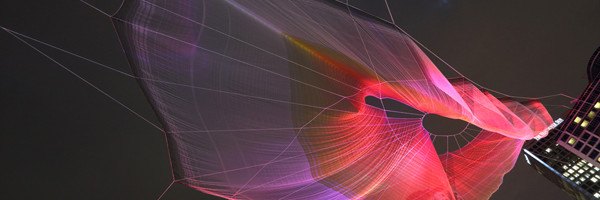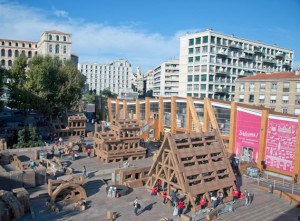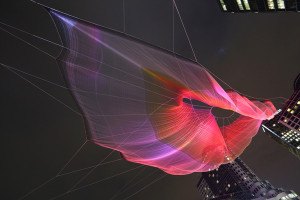From drawings on a board to interactive apps – crowdsourced art

Collaborative art is not an entirely new concept but has become easier than ever with the advent of digital technology. Large installations such as ‘Unnumbered Sparks’ have brought crowds and technology together to allow large-scale art projects that were previously impossible.
Collaborative art emerged in the late 1950s and presented a radical paradigm shift from the artist as creator and fully separate from the audience, with the output of his creation to be displayed in museums and galleries, to a form of art more integrated into the public space and with participation from citizens in its creation. This art movement has to be seen in the context of the societal changes occurring during that time period, and as such often was taking political or ideological issues such as minorities in society, feminism, or environmentalism. In general, the overall framework and objectives were still always determined by the artist, bringing this model in fact much closer to crowdsourcing within communities.

This century, crowdsourcing art pieces has continued becoming more common. For example, Olivier Grossetête has toured European cities with his ephemeral cardboard constructions built by thousands of participants. In those, the local population is invited to help build large buildings out of cardboard boxes. Digital innovation has allowed to access a wider variety of people and contents – for instance, videos, phone and internet data have all been turned into art.

Aaron Koblin (currently creative director of data arts at Google) has had numerous experiences in the space of crowdsourced art. He created the interactive art for Skies painted with unnumbered sparks (sculpture by Janet Echelman), wherein the sculpture becomes animated by users underneath it through a mobile phone app. This piece was commissioned for the 30th anniversary of the TED conference and exists thanks to the crowds that animate it.

Koblin’s 2006 The sheep market used Amazon’s crowdsourcing platform “Mechanical Turk”, where human intelligence tasks can be listed by companies or individuals for workers to perform. Workers get paid an agreed upon rate; in Koblin’s case he asked users to draw “sheep facing to the left” for his project, paying workers 2 cents per drawing. The output of this work was simply the collection of 10,000 drawings. Additionally, he was able to sell those at $1 per piece, i.e. at a significant margin, thus creating an interesting piece of art part “cute crowdsourced project”, part social commentary on a somewhat dystopian view of the “Mechanical turk”.

As usual in the art space, value creation and value capture can be hard to exactly analyze. I would argue that value creation is the simple act of creating an art piece that means something to its viewers. In crowdsourced art, viewers are also often the makers: clearly the value for those actually involved in the making is increased through enhanced meaning attributed to the piece, and increased view of the self as an “art maker”, compared with being a passive viewer. Interestingly, those are also the ones creation. There is also clear value capture on the artist’s side – he can benefit from thousands of man-hours at virtually no cost, enabling a completely different scale of projects. In doing so, technology has been a great aid in accessing people much more efficiently. Value capture is of course also present from organizations that commission art, who can thus access large art pieces at a reduced cost (though pricing in art is also highly non-linear).
Today crowdsourcing is more of an artist to artist choice and there is no business actor in that space who has been able to monetize the concept on a large scale. Due to the highly individual nature of art, it is difficult to imagine how such a business would look like – perhaps a service app connecting artists to art consumers and allowing consumers to collaborate in whichever way they can, in the same way that jobs are posted? It will definitely be fascinating to follow the evolution of the intersect of art, technology and crowds.
Sources:
(1) History of collaborative art: http://interartive.org/2013/10/collaborative-art/
(2) T. Morse, All together now: crowds and crowdsourcing, Sept 2014, in Artnews.com, http://www.artnews.com/2014/09/02/artists-and-crowdsourcing/
(3) Olivier Grossetête, http://documentsdartistes.org/artistes/grossetete/repro2e.html, http://www.in-situ.info/fr/creations/ville-ephemere/67
(4) Unnumbered Sparks video: http://www.unnumberedsparks.com/
(5) Aaron Kobline Tedtalk, https://www.ted.com/talks/aaron_koblin?language=en


